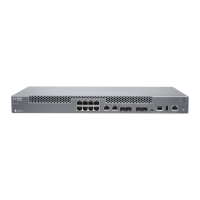CHAPTER 18
Alarm Messages
•
Understanding Alarm Types and Severity Levels on MX150 on page 117
Understanding Alarm Types and Severity Levels on MX150
Alarms alert you to conditions that might prevent normal operation of the MX150.
Table 29 on page 117 provides a list of alarm terms and definitions that might help you in
monitoring the device.
Table 29: Alarm Terms and Definitions
DefinitionTerm
Signal alerting you to conditions that might prevent normal operation. LEDs are the alarm indicators on
the device. Blinking amber LEDs indicate yellow alarm conditions for chassis components.
Alarm
Failure event that triggers an alarm.Alarm condition
Seriousness of the alarm. The level of severity can be either major (red) or minor (yellow).
•
Major (red)—Indicates a critical situation on the device that has resulted from one of the following
conditions. A red alarm condition requires immediate action.
•
One or more hardware components have failed.
•
One or more hardware components have exceeded temperature thresholds.
•
An alarm condition configured on an interface has triggered a critical warning.
•
Minor (yellow or amber)—Indicates a noncritical condition on the device that, if left unchecked, might
cause an interruption in service or degradation in performance. A yellow alarm condition requires
monitoring or maintenance. For example, a missing rescue configuration generates a yellow system
alarm.
Alarm severity
levels
Alarms include the following types:
•
Chassis alarm—Predefined alarm triggered by a physical condition on the device such as a power supply
failure or excessive component temperature.
•
Interface alarm—Alarm you configure to alert you when an interface link is down. Applies to ethernet,
fibre-channel, and management-ethernet interfaces. You can configure a red (major) or yellow (minor)
alarm for the link-down condition, or have the condition ignored.
•
System alarm—Predefined alarm that might be triggered by a missing rescue configuration, failure to
install a license for a licensed software feature, or high disk usage.
Alarm types
117Copyright © 2017, Juniper Networks, Inc.

